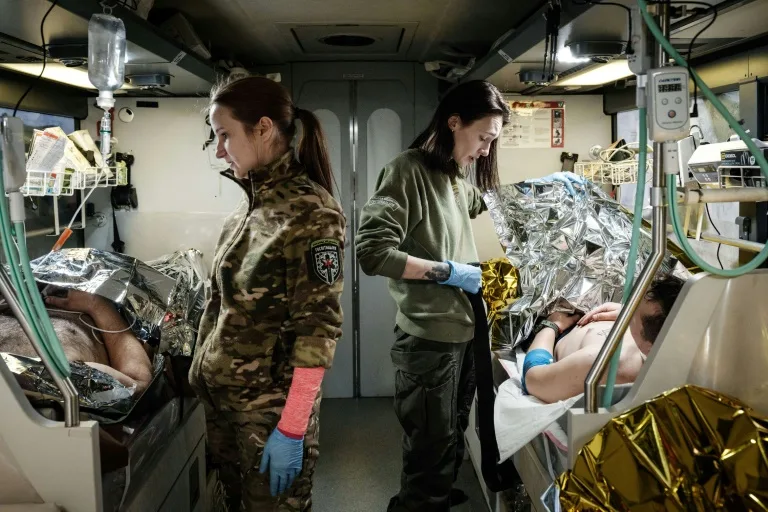(AFP) On the roads of eastern Ukraine, a few kilometers from the front, a wounded soldier is evacuated aboard a ambulance bus where he receives care from an emergency “medical battalion.
Four other combatants soon arrive, and with the help of crutches, they struggle to get to their seats in this mobile ambulatory adorned with sunflowers, one of Ukraine’s emblems. These vehicles have become a familiar symbol on the region’s highways, where the main fighting takes place.
From the outside, the vehicle looks like any long-distance bus traveling on country roads. But inside, amidst medical apparatus, volunteer paramedics work with soldiers wounded by bullets, artillery shrapnel, and mines. The vehicle has six beds.
These soldiers will soon be transferred to local hospitals and sometimes to specialized facilities for long-term treatment.
“We never lost a patient on the way to the hospital,” celebrates 24-year-old Dmytro Satchkov, whose medical studies were interrupted by the war.
“Every day we get a call. In one week, we removed 62 people,” he told AFP.
- Deep wounds
The bus is used by the “medical battalion” created since 2014, when conflict broke out with the Moscow-backed pro-Russian separatists.
The battalion, aided by a fleet of ambulances, is made up of volunteer first responders from Ukraine and elsewhere.
In Donbass, the region that Moscow aims to conquer, the buses come and go several times in a day to take the wounded to hospitals located near the front line.
The workload “depends on the intensity of the fighting,” explains Dmytro Satchkov, wearing a military uniform and carrying a bag with first aid items attached to his leg.
“We are willing to make as many trips as we can, but it is not an evacuation vehicle and it is difficult to drive it on bad roads,” the young doctor adds.
Heading west towards Pavlograd in the Dnipropetrovsk region, the bus makes its way slowly and avoids potholes to avoid further inconvenience to the injured.
The most seriously injured are lying under insulating blankets while their vital signs are continuously monitored electronically.
Yuri Popenko, 37, was injured by a mine in the city of Bakhmut, the epicenter of the clashes where Russian troops have been regaining ground for weeks. His two ankles are fractured.
In the back of the bus, Vassyl Iavtouchenko has his face wounded by mortar fragments and his hands are bandaged.
“I have very deep injuries,” he says. “The doctors gave me stitches, it will be quick, but I believe recovery will take a month,” he adds.
- “Keep up the spirits”
For Dmytro Satchkov, who also helps train the new paramedics, the experience of serving in wartime is invaluable. It allows him to acquire vital skills that he could not get elsewhere.
“Our doctors don’t just learn in class, they learn and study in the field as well,” between examining one patient and another.
Olena Guerassymiouk, 31, administers painkillers and performs IV infusions while the bus struggles with traffic and military blockades.
A poet and activist, she started volunteering five years ago and is now a qualified paramedic.
“The hardest thing is to keep up the spirits. When there are people with very serious injuries, it’s very difficult,” Olena admits.
“Sometimes you are on the verge of collapse, but you can’t stop so as not to discourage the injured. They are heroes,” she concludes.
*** Translated by the DEFCONPress FYI team ***
